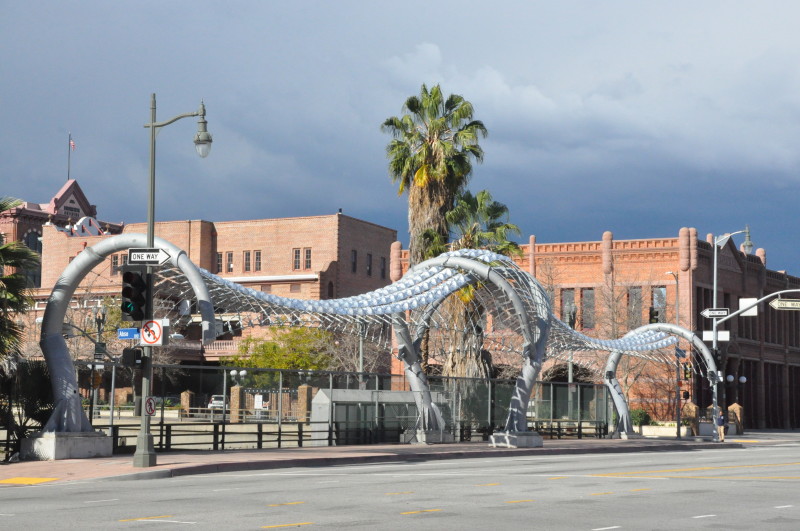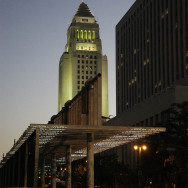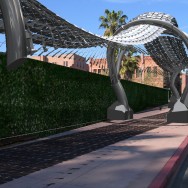Two sculptures in downtown LA, in construction now!
Follow construction progress on Aperiodic Industries page.
Los Angeles, CA Pedestrians traversing the 101 on their way to or from Union Station or the El Pueblo Historical Monument and world famous Olvera Street from the historic core of downtown and civic center will soon have new experiences waiting for them in the form of two new public art installations currently nearing completion. Conceived by a team comprised of Jenna Didier, Oliver Hess, Ned Kahn and Marcos Lutyens, these sculptures were commissioned by the Department of Transportation with the guidance of the Department of Cultural Affairs as the second phase to a pedestrian improvement project for the two bridges that span the 101 Freeway on Los Angeles Street and Main Street – the first phase widened the sidewalks.
The artists’ vision sprang from a desire to use the vernacular of the freeway, in other words, the aesthetic of CalTrans, but warp this into something beautiful and engaging to the general public – the infrastructures we build are a reflection of our culture and they send a message to the future. As Hess completed the final renders, giving shape to some initial ideas, the concepts’ forms emerged. The Los Angeles Street canopy was presented as a sweeping gestural archway that draws upon iconic elements like a large wave closing out on the shore and flocking patterns of birds. The 100’ long expanse provides an experience of the pergola at the scale of these natural phenomena. In order to create a continuous expanse, Hess drew upon a technique he had developed for a previous installation that incorporates a node and grid system. The LED lights embedded in the formed aluminum “nodes” that cover the grid of stainless steel netting will illuminate each night and will display a subtle yet telling story of the vibration of the bridge via the use of a geophone similar to those geologists use to measure earthquakes.
As a counterpoint to the technology dependent vibration measurement of Los Angeles Street Pergola, the one on Main Street uses passive mechanics to visualize seismic activity. The entire upper section of the sculpture is a series of pendula which can swing freely for a few degrees but are carefully controlled beyond that to provide a safe illustration of the bridge’s movement. Measurement devices are embedded into the structure and allow for various insights, including the presence of “love waves”, a rare seismic phenomena where the liquefaction of earth allows a perpendicular wave to propagate over the surface of the earth, in this case these are measured traveling from the east to the west and back.
Beginning in 2008, Didier and Hess developed the concept and continued through the design process until its final review and acceptance by both the LA Department of Cultural Affairs and community stakeholders. They then worked closely with an engineering team that included Matt Melnyk of Nous Engineering, Dan Weddell of WKE, Buro Happold, the LA Public Works Engineering Bureau with Jim Treadaway as City Program Manager and Tim Fu as Construction Manager, (followed previously by Arrash Agahi, and Ing Jones), CalTrans and numerous specialized engineering firms. The artworks were constructed by ACON Construction with several specialized sub contractors including CadWorks and Fabritech.
As construction began, Hess continued to consult and guide the process from prototyping through the installation from his studio in Glassell Park, Aperiodic Industries. There he hosted a series of public workshops and intensive studies of the subtler aspects of the pergolas’ design and engineering to attain that extra level of detail that the artworks required in order to make them truly inviting and memorable.
Although designed as pedestrian enhancements, the pieces are visible from the 101 freeway from both north and southbound lanes and will function for millions as “The Gateway to Los Angeles” whether they arrive via freeway, rail, bicycle or on foot.
- concept render by oliver hess
- concept render by oliver hess
- main st at night
- la street at night
- la street seen through main st
- concept render by oliver hess
- center of la street photo by oliver hess
- la street day








